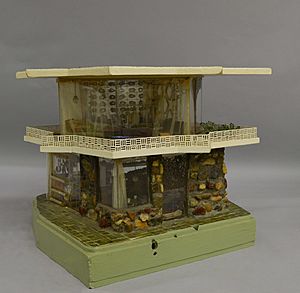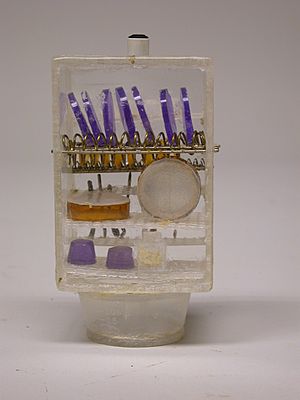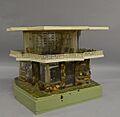Frances Gabe facts for kids
Quick facts for kids
Frances Gabe
|
|
|---|---|
| Born | June 23, 1915 Idaho, USA
|
| Died | December 26, 2016 (age 101) Oregon, USA
|
| Nationality | American |
| Occupation | Inventor, artist |
|
Notable work
|
Self-Cleaning House |
Frances Gabe (born Frances Grace Arnholtz, June 23, 1915 – December 26, 2016) was an American inventor and artist. She is most famous for creating the world's first "self-cleaning house" in Newberg, Oregon. In the 1970s, Frances was tired of how much time house chores took. She decided to invent a house that could clean itself!
In 1984, she received a special patent for her amazing invention. This patent included 68 different inventions. These inventions used sprinklers and drying units to wash and dry almost everything. This included walls, clothes, and even dishes! Dirty water would then flow out of the house through special drains in the floor. Frances Gabe and her unique house were featured in People magazine in 1982. They also appeared in The New York Times and on Phil Donahue’s talk show. A model of her house was shown at The Women's Museum in Dallas, Texas from 2002 to 2003. It is now part of the Hagley Museum and Library's collection.
Contents
Early Life and Education
Frances Gabe was born in 1915 on a ranch near Boise, Idaho. Her mother, Erenstine, passed away when Frances was very young. She spent most of her childhood with her father, Frederick. He worked as a building contractor and architect. This meant Frances grew up around construction sites.
Her family moved often for her father's work. Because of this, Frances attended eighteen different elementary schools. In 1929, she graduated from the Girl's Polytechnic School in Portland, Oregon. She was only sixteen years old. Frances finished six years of middle school and high school in just two years! She found school moved too slowly for her. She once told writer Chuck Palahniuk, "I was born a most unusual person, so I had a heck of a time in school. Everything moved much too slowly."
Personal Life
In 1932, Frances married Herbert Bateson, who was an electrical engineer. They had two children together. For many years, they ran a construction and maintenance company. Later, in the 1970s, Frances and Herbert ended their marriage. After this, Frances changed her last name. She created "Gabe" by combining letters from her maiden and married names: Grace, Arnholtz, Bateson, and E.
The Self-Cleaning House
Frances Gabe's big invention came from her frustration with chores. She wondered, "Why waste time loading a dishwasher, then unloading it and putting them in the cupboard? Why can't dishes be washed in the cupboard and save time?" She wanted to get rid of the endless job of cleaning.
Using her own money and building skills, Frances built a special house on her property in Newberg. This house was filled with devices designed to wash and dry the inside of the home. She applied for a patent in 1980. On January 31, 1984, she finally received patent number 4,428,085 for her "Self-Cleaning Building Construction."
Her patent explained how it worked:
- The house had a system to spray a fine mist of water and soap onto walls, floors, and ceilings.
- After washing, warm air would dry everything.
- The floors were sloped so that extra water would drain away.
- The house also included special closets to clean clothes.
- There were cupboard dishwashers to clean dishes while they were stored.
- Even the bathtub and washbasin could clean themselves!
Frances built a two-story model of her patented house. She traveled around the country, giving interviews and lectures. She hoped to get people interested and sell the rights to her invention. Sadly, she never found a buyer. Her house remained the only one of its kind. Over the years, she offered tours of her home for a small fee. However, this was not enough to keep up with her patent fees or the house's maintenance.
Later Life and Legacy
Frances Gabe lived a very long life. She passed away at the age of 101 in December 2016. She was living in a nursing home at the time. For a while, her invention was largely forgotten. However, in July 2017, The New York Times published an obituary about her. This article brought new interest to her story. Other publications, like Smithsonian Magazine and MIT, also wrote articles about her.
Frances Gabe's house was sold when she moved to the nursing home. The house is still standing today. However, most of the self-cleaning features have been removed by the current owner.
In 2005, artist Lily Benson visited Frances Gabe's home. This visit inspired Lily to create a short film based on Frances's invention. The film was released in 2015. Frances Gabe's vision of a self-cleaning home continues to inspire people today.
Images for kids
See also
 In Spanish: Frances Gabe para niños
In Spanish: Frances Gabe para niños





